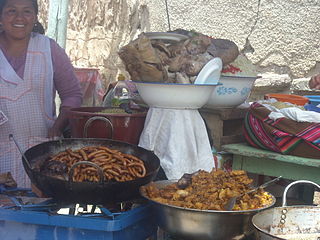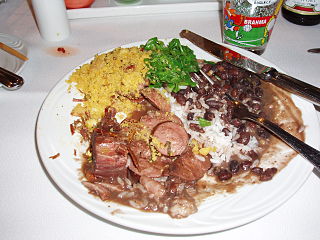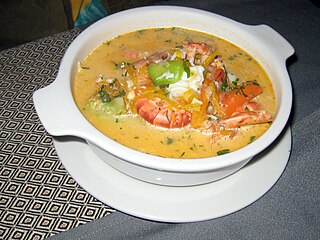Chupe andino refers to various stews and soups that are prepared in the Andes mountains region in South America. [1] [2] Chupe Andino may be prepared by Andean people, those that live in the region. [2] It is sometimes prepared in large portions to feed many people at marketplaces and events. [3] [4] Chupe Andino is sometimes served with wine as an accompaniment. [1] [2] Soups and stews play a significant part in Andean cuisine, because the cold weather in the region demands nutritious, fatty foods that are warming. [2]
The term chupe is a standard South American term that refers to various stews prepared with meats, [5] fish [6] and seafood, tripe and offal. Additional ingredients may include potato, onion, garlic and cheese. [6] In the past, it has been prepared using yuca as an ingredient. [5]

Chowder is a type of soup or stew often prepared with milk or cream and thickened with broken crackers, crushed ship biscuit, or a roux. Variations of chowder can be seafood or vegetable. Crackers such as oyster crackers or saltines may accompany chowders as a side item, and cracker pieces may be dropped atop the dish. New England clam chowder is typically made with chopped clams and diced potatoes, in a mixed cream and milk base, often with a small amount of butter. Other common chowders include seafood chowder, which includes fish, clams, and many other types of shellfish; lamb or veal chowder made with barley; corn chowder, which uses corn instead of clams; a wide variety of fish chowders; and potato chowder, which is often made with cheese. Fish chowder, corn chowder, lamb chowder and especially clam chowder are popular in the North American regions of New England and Atlantic Canada.

Ceviche, also cebiche, seviche, or sebiche, is a seafood dish originating in Peru typically made from fresh raw fish cured in citrus juices, such as lemon or lime, and spiced with ají, chili peppers or other seasonings including chopped onions, salt and coriander. Because the dish is not cooked with heat, it must be prepared and consumed fresh to minimize the risk of food poisoning. Ceviche is usually accompanied by side dishes that complement its flavours, such as sweet potato, lettuce, corn, avocado or cooking banana. The dish is popular in the Pacific coastal regions of Latin America. Though the origin of ceviche is hotly debated, in Peru it is considered a national dish.

South American cuisine has many influences, due to the ethnic fusion of South America. The most characteristic are Native American, African, Spanish, Italian, Portuguese, and Indian-South Asian. However, there is a mix of European, North American, and indigenous cuisines. The customs and food products greatly vary according to the physically distinct regions.

Offal, also called variety meats, pluck or organ meats, is the viscera and entrails of a butchered animal. As an English mass noun, the term "offal" has no plural form. The word does not refer to a particular list of edible organs, which varies by culture and region, but includes most internal organs and excludes muscle and bone. Offal may also refer to the by-products of milled grains, such as corn or wheat.

Latin American cuisine is the typical foods, beverages, and cooking styles common to many of the countries and cultures in Latin America. Latin America is a highly diverse area of land that holds various cuisines that vary from nation to nation. Some items typical of Latin American cuisine include maize-based dishes arepas, pupusas, tacos, tamales, tortillas and various salsas and other condiments. These spices are generally what give the Latin American cuisines a distinct flavor; yet, each country of Latin America tends to use a different spice and those that share spices tend to use them at different quantities. Thus, this leads for a variety across the land. Sofrito, a culinary term that originally referred to a specific combination of sautéed or braised aromatics, exists in Latin American cuisine. It refers to a sauce of tomatoes, roasted bell peppers, garlic, onions and herbs.

Locro is a hearty thick stew, associated with native Andean civilizations, and popular along the Andes mountain range. It's one of the national dishes of Argentina, Peru, Bolivia, Ecuador and Southern Colombia.

Peasant foods are dishes specific to a particular culture, made from accessible and inexpensive ingredients, and usually prepared and seasoned to make them more palatable. They often form a significant part of the diets of people who live in poverty, or have a lower income compared to the average for their society or country.

Hallaca is a dish from Venezuela It consists of corn dough stuffed with a stew of beef, pork, or chicken and other ingredients such as raisins, capers, and olives Like some tamales, hallacas are folded in plantain leaves, tied with strings, and boiled; The dish is traditionally served during the Christmas season and has several regional variants in Venezuela. It has been described as a national dish of Venezuela but it can be found also in variants. Some speculate it originated from the Orinoquia. A characteristic of the hallaca is the delicate corn dough made with consommé or broth and lard colored with annatto. Hallacas are also commonly consumed in eastern Cuba parts of Colombia, and Ecuador.

Gofio is a sort of Canarian flour made from roasted grains or other starchy plants, some varieties containing a little added salt. Gofio has been an important ingredient in Canarian cooking for some time, and Canarian emigrants have spread its use to the Caribbean and the Western Sahara. It is also found in Argentina, Uruguay, and Chile, where it is known as harina tostada and is employed in a wide variety of recipes. The gofio commercially available in the Canary Islands is always finely ground, like ordinary flour, despite the definition given in the Spanish Dictionary of the Royal Academy.

Chupe is a generic term used in South America to a variety of stew generally made with chicken, red meat, lamb or beef tripe and other offal, or with fish, shrimp, crayfish or shellfish such as loco, and vegetables, potatoes or yuca.

Gastón Acurio Jaramillo is a Peruvian chef and ambassador of Peruvian cuisine. He is the owner of restaurants in several countries and is the author of several books. In Peru he is the host of his own television program and contributes to a few magazines.

Chilean gastronomy stems mainly from the combination of traditional Spanish cuisine, Chilean Indigenous Mapuche culture and local ingredients, with later important influences from other European cuisines, particularly from Germany, Italy and France. The food tradition and recipes in Chile are notable for the variety of flavours and ingredients, with the country's diverse geography and climate hosting a wide range of agricultural produce, fruits and vegetables. The long coastline and the peoples' relationship with the Pacific Ocean add an immense array of seafood products to Chilean cuisine, with the country's waters home to unique species of fish, molluscs, crustaceans and algae, thanks to the oxygen-rich water carried in by the Humboldt Current. Chile is also one of the world's largest producers of wine and many Chilean recipes are enhanced and accompanied by local wines.

Soup is a primarily liquid food, generally served warm or hot, that is made by combining ingredients of meat or vegetables with stock, or water. Hot soups are additionally characterized by boiling solid ingredients in liquids in a pot until the flavors are extracted, forming a broth. Soups are similar to stews, and in some cases there may not be a clear distinction between the two; however, soups generally have more liquid (broth) than stews.

Puchero is a type of stew originally from Spain, prepared in Yucatán, Mexico, Argentina, Paraguay, Uruguay, Perú, south of Brazil, the Philippines, and Spain, specifically the autonomous communities of Andalusia and the Canary Islands. The name comes from the Spanish word "puchero" which means "stewpot".

Prawn soup, also referred to as shrimp soup, is a soup dish prepared using freshwater or saltwater prawns as a primary ingredient. Several varieties of the dish exist in various areas of the world, including Penang Prawn Mee in Malaysia, Peruvian chupe de camarones, Thai kaeng som kung and Mexican caldo de camarones, among others. Prawn and shrimp soup can be prepared as a broth- or stock-based soup, as a cream-based soup, or as a chowder. In the United States, cream of shrimp soup is mass-produced and distributed canned or frozen.

Mote is the generic name for several varieties of corn grains boiled, consumed in many regions of South America. It is usually prepared by boiling the grains in water made alkaline by the addition of ashes or lime, a process known as nixtamalization.

A stew is a combination of solid food ingredients that have been cooked in liquid and served in the resultant gravy. Ingredients in a stew can include any combination of vegetables and may include meat, especially tougher meats suitable for slow-cooking, such as beef. Poultry, sausages, and seafood are also used. While water can be used as the stew-cooking liquid, stock is also common. Seasoning and flavourings may also be added. Stews are typically cooked at a relatively low temperature, allowing flavours to mingle.

Corn stew is a stew prepared with corn (maize) as a primary ingredient. Many variations exist in ingredient usage and in methods of preparation. Corn stew is a dish in several cuisines of the world. Mazamorra is an historically old corn stew dish in South America that is prepared using simple ingredients, and is a dish in several other cuisines.